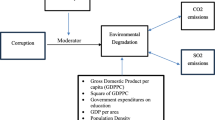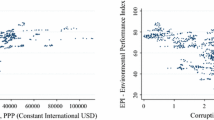Abstract
The impact of corruption on environment quality is a challenge for both developed and developing countries. Using the panel quantile regression approach and the generalized method of moments (GMM), this paper examines the linkers between corruption and CO2 emissions in African countries. Empirical results show that the corruption level is high for all African economies. Also, the effect of corruption on CO2 emissions is negative in lower emissions countries. But, this effect becomes insignificant for higher emissions countries. However, its indirect effect on CO2 emissions is positive. But, the positive effect of corruption on environment quality dominates the negative effect. The end result is a total positive effect, i.e., African countries suffer from higher level of corruptability which eventually causes many serious ecological problems.
Similar content being viewed by others
References
Abed, G. T. & Gupta, S. (2002) Governance, corruption, and economic performance. International Monetary Fund. https://doi.org/10.5089/9781589061163.071
Ahmed, K., & Long, W. (2012). Environmental Kuznets curve and Pakistan: an empirical analysis. Procedia Economics and Finance, 1, 4–13.
Alam, M. M., Murad, M. W., Noman, A. H. M., & Ozturk, I. (2016). Relationships among carbon emissions, economic growth, energy consumption and population growth: Testing environmental Kuznets curve hypothesis for Brazil, China, India and Indonesia. Ecological Indicators, 70, 466–479.
Alexander, M., Harding, M., & Lamarche, C. (2011). Quantile regression for time-series-crosssection data. International Journal of Statistics & Management Systems, 6(1–2), 47–72.
Al-Mulali, U., Saboori, B., & Ozturk, I. (2015). Investigating the environmental Kuznets curve hypothesis in Vietnam. Energy Policies, 76(2015), 123–131.
Anderson, C. J., & Tverdova, Y. V. (2003). Corruption, political allegiances, and attitudes toward government in contemporary democracies. American Journal of Political Science, 47(1), 91–109.
Ang, J. B. (2007). CO2 emissions, energy consumption, and output in France. Energy Policies, 35(10), 4772–4778.
Apergis, N., & Payne, J. E. (2009). CO2 emissions, energy usage, and output in Central America. Energy Policies, 37, 3282–3286.
Arellano, M., & Bond, S. (1991). Some tests of specification for panel data: Monte Carlo evidence and an application to employment equations. The Review of Economic Studies, 58, 277–297.
Arouri M., Shahbaz M., Onchang R., Islam F. & Teulon F. (2014) Environmental Kuznets curve in Thailand: cointegration and causality analysis, Working Paper, 2014- 204; 2014.
Baek, J., & Pride, D. (2014). On the income-nuclear energy-CO2 emissions nexus revisited. Energy Economics, 43, 6–10.
Basarir, A., & Arman, H. (2014). The effects of economic growth on environment: an application of environmental Kuznets curve in United Arab Emirates. Online Journal of Science and Technology, 4(1), 53–59.
Begum, R. A., Sohag, K., Abdullah, S. M. S., & Jaafar, M. (2015). CO2 emissions, energy consumption, economic and population growth in Malaysia. Renewable and Sustainable Energy Reviews, 41, 594–601.
Bellos, S., & Subasat, T. (2012). Corruption and foreign direct investment: a panel gravity model approach. Bulletin of Economic Research, 64(4), 565–574.
Biswas, A. K., Farzanegan, M. R., & Thum, M. (2012). Pollution, shadow economy and corruption: Theory and evidence. Ecological Economics, 75, 114–125.
Borhan H. B., Hitam M. B., Mohamed R. N. & Muda M. (2012) Income and CO2 in China and Malaysia from environmental Kuznets curve perspective. In: Proceedings of the Cambridge Business & Economics Conference Cambridge, UK, June 27–28.
Chimeli, A. B., & Braden, J. B. (2005). Total factor productivity and the environmental Kuznets curve. Journal of Environmental Economics and Management, 49(2), 366–380.
Cole, M. A. (2007). Corruption, income and the environment: an empirical analysis. Ecological Economics, 62(3), 637–647.
Cooraya, A., Dzhumashevb, R., & Schneiderc, F. (2017). How does corruption affect public debt?An Empirical Analysis. World Development, 90, 115–127.
Damette, O., & Delacote, P. (2012). On the economic factors of deforestation: what can we learn from quantile analysis? Economic Modelling, 29(6), 2427–2434.
Damiana, et al. (2003). Trade liberalization, corruption, and environmental policies formation: Theory and evidence. Journal of Environmental Economics and Management, 46(3), 490–512.
Desai, U. (1998). Ecological policies and politics in developing countries: growth, democracy and environment. Albany: State University of New York Press.
Esso, L. J., & Keho, Y. (2016). Energy consumption, economic growth and carbon emissions: cointegration and causality evidence from selected African countries. Energy, 114, 492–497.
Fisman, R., & Svensson, J. (2007). Are corruption and taxation really harmful to growth? Firm level evidence. Journal of Development Economics, 83(1), 63–75.
Fredriksson, et al. (2004). Corruption and energy efficiency in OECD countries: theory and evidence. Journal of Environmental Economics and Management, 47, 207–231.
Grooms, K. K. (2015). Enforcing the clean water act: the effect of state-level corruption on compliance. Journal of Environmental Economics and Management, 73, 50–78.
Hafner O. (1998). The role of corruption in the misappropriation of tropical forest resources and in tropical forest destruction. Transparency International Working Paper.
Hakkala, K. N., Norbäck, P. J., & Svaleryd, H. (2008). Asymmetric effects of corruption on FDI: evidence from Swedish multinational firms. The Review of Economics and Statistics, 90(4), 627–642.
Hanifa, I., & Gago-de-Santos, P. (2017). The importance of population control and macroeconomic stability to reducing environmental degradation: An empirical test of the environmental Kuznets curve for developing countries. Environmental Development., 23, 1–9. https://doi.org/10.1016/j.envdev.2016.12.003.
Hansen, B., & Østerhus, S. (2000). North Atlantic Nordic seas exchanges. Progress in Oceanography, 45(2), 109–208.
Hayashi. (2000). “Econometrics”, is published by Princeton University Press and copyrighted, 2000, by Princeton University Press, Princeton.
Huang, C. J. (2016). Is corruption bad for economic growth? Evidence from Asia-Pacific countries. The North American Journal of Economics and Finance., 35(1), 247–256.
Imran, A. B., Roshan, A., Naeem, A., Zulfiqar, A. (2017). Traditional rice farming accelerate CH4 & N2O emissions functioning as a stronger contributors of climate change. Agri Res & Tech J, 9(3), 555765. https://doi.org/10.19080/ARTOAJ.2017.09.555765.
Jain, A. K. (2001). Corruption: a review. Journal of Economic Surveys, 15(1), 71–121.
Jebli, M. B., & Youssef, S. B. (2015). The environmental Kuznets curve, economic growth, renewable and non-renewable energy, and trade in Tunisia. Renewable and Sustainable Energy Reviews, 47(2015), 173–185.
Kanjilal, K., & Ghosh, S. (2013). Environmental Kuznet’s curve for India: evidence from tests for cointegration with unknown structural breaks. Energy Policies, 56, 509–515.
Kaufmann, D., & Kraay, A. (2008). Governance indicators: where are we, where should we be going? The World Bank Research Observer, 23(1), 1–30.
Koenker, R. (2004). Quantile regression for longitudinal data. Journal of Multivariate Analysis, 91(1), 74–89.
Lamarche, C. (2011). Measuring the incentives to learn in Colombia using new quantile regression approaches. Journal of Development Economics, 96(2), 278–288.
Lee, J. S., Huang, G. L., Kuo, C. T., & Lee, L. C. (2012). The momentum effect on Chinese real estate stocks: evidence from firm performance levels. Economic Modelling, 29(6), 2392–2406.
Leitao, A. (2010). Corruption and the environmental Kuznets Curve: empirical evidence for sulfur. Ecological Economics, 69(11), 2191–2201.
Loesse, J. E., & Yaya, K. (2016). Energy consumption, economic growth and carbon emissions: cointegration and causality evidence from selected African countries. Energy, 114, 492–497.
Lopez, R., & Mitra, S. (2000). Corruption, pollution, and the Kuznets environment curve. Journal of Environmental Economics and Management, 40(2), 137–150.
Mauro, P. (1995). Corruption and growth. Quarterly Journal of Economics, 110(3), 681–713.
Olugbenga, A. O., & Oluwole, O. (2013). Carbon emissions and income trajectory in eight heterogeneous countries: the role of trade openness, energy consumption and population dynamics. Journal of Global Economy, 9, 85e122.
Ozturk, I., & Al-Mulali, U. (2015). Investigating the validity of the environmental Kuznets curve hypothesis in Cambodia. Ecological Indicators, 57, 324–330.
Paunov C. (2016). Corruption’s asymmetric impacts on firm innovation. Journal of Development Economics, 118, 216–231.
Pellegrini, L., & Gerlagh, R. (2006). Corruption and environmental policies: what are the implications for the enlarged EU. European Environment, 16(3), 139–154.
Rabah, A., & Markus, B. (2011). Oil rents, corruption, and state stability: evidence from panel data regressions. European Economic Review, 55(2011), 955–963.
Rock, M. T., & Bonnett, H. (2004). The comparative politics of corruption: accounting for the East Asian paradox in empirical studies of corruption, growth and investment. World Development, 32(6), 999–1017.
Saboori, B., Sulaiman, J., & Mohd, S. (2012). An empirical analysis of the environmental Kuznets curve for CO2 emissions in Indonesia: the role of energy consumption and foreign trade. International Journal of Economics and Finance, 4(2), 243–251.
Schneider, F., Buehn, A., & Montenegro, C.E.( 2010) Shadow economies all over the world new estimates for 162 countries from 1999 to 2007. The World Bank Policy Research working paper 5356, The World Bank, Washington, D.C.
Sekrafi, H., & Sghaier, A. (2016). Examining the relationship between corruption, economic growth, environmental degradation, and energy consumption: a panel analysis in MENA region. Journal of the Knowledge Economy, 9, 963–979. https://doi.org/10.1007/s13132-016-0384-6.
Seldadyo, H., & De Haan, J. (2011). Is corruption really persistent? Pacific Economic Review, 16(2), 192–206.
Shahbaz, M., Lean, H. H., & Shabbir, M. S. (2012). Environmental kuznets curve hypothesis in Pakistan: cointegration and granger causality. Renewable and Sustainable Energy Reviews, 16(5), 2947–2953.
Shahbaz, M., Solarin, S. A., & Ozturk, I. (2016). Environmental Kuznets curve hypothesis and the role of globalization in selected African countries. Ecological Indicators, 67, 623–636.
Shleifer, A., & Vishny, R. W. (1993). Corruption. Quarterly Journal of Economics, 108(3), 599–617.
Transparency International. (2015). https://www.transparency.org/cpi2015. Accessed 2017.
Walter, M., & Luebke, M. A. (2013). The impact of corruption on climate change: threatening emissions trading mechanisms. Environmental Development., 7, 128–138.
Wang, Q., Zhao, Z., Shen, N., & Liu, T. (2015). Have Chinese cities achieved the win-win between environmental protection and economic development? From the perspective of environmental efficiency. Ecological Indicators, 51, 151–158.
Zhang, Y. J., & Da, Y. B. (2015). The decomposition of energy-related carbon emission and its decoupling with economic growth in China. Renewable and Sustainable Energy Reviews, 41, 1255–1266.
Zhang, Y.-J., Jin, Y.-L., Chevallier, J., & Shen, B. (2016). The effect of corruption on carbon dioxide emissions in APEC countries: A panel quantile regression analysis. Technological Forecasting and Social Change, 112, 220–227.
Author information
Authors and Affiliations
Corresponding author
Additional information
Publisher’s Note
Springer Nature remains neutral with regard to jurisdictional claims in published maps and institutional affiliations.
Rights and permissions
About this article
Cite this article
Habib, S., Abdelmonen, S. & Khaled, M. The Effect of Corruption on the Environmental Quality in African Countries: a Panel Quantile Regression Analysis. J Knowl Econ 11, 788–804 (2020). https://doi.org/10.1007/s13132-018-0571-8
Received:
Accepted:
Published:
Issue Date:
DOI: https://doi.org/10.1007/s13132-018-0571-8




